Discover the fascinating world of animals adorned with magnificent antlers. Among these remarkable creatures are the caribou and reindeer, which uniquely possess antlers in both males and females. Other examples include the elk, fallow deer, moose (known for having the largest antlers), mule deer, white-tailed deer, sambar, chital, and taruca.
Prepare to be captivated by the pictures and intriguing facts about these animals with antlers. Delve into the purpose of antlers, their composition, and the distinctions between antlers and horns.
Which animals boast the presence of antlers? Solely deer belong to the exclusive group of antler bearers. Deer are hoofed mammals classified under the family Cervidae, with 51 recognized species. (source)
It’s important to differentiate antlers from horns. Antlers undergo annual growth and shedding, while horns remain permanently attached to an animal’s head throughout its life.
Animals With Antlers
Let’s explore the various animals with antlers:
1. Caribou
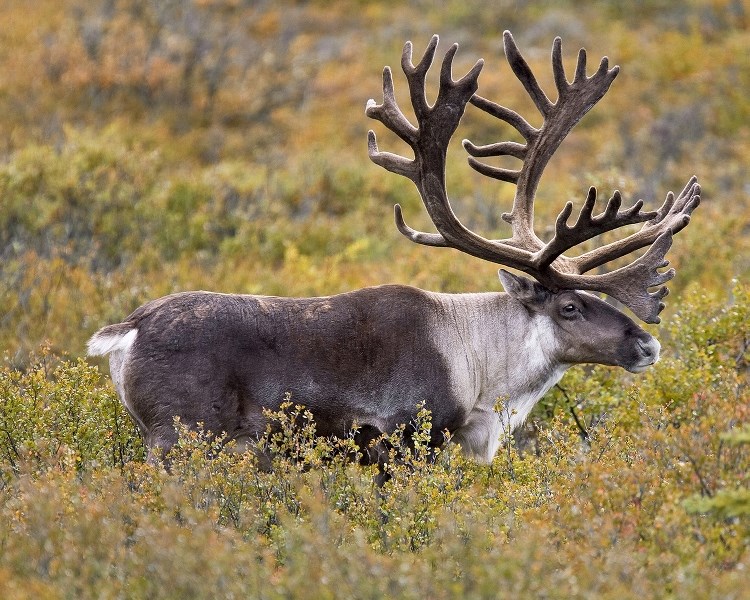
- Scientific name: Rangifer tarandus
- Habitat: North America, Europe, Asia (Siberia)
- Conservation status: Vulnerable
- Antler dimensions: Width: 100 cm / 3.28 ft.; Length: 135 cm / 4.43 ft.
Caribou, also known as reindeer, are majestic deer inhabiting Arctic and sub-Arctic regions of the northern hemisphere.
In the wild, caribou are found in North America, while those in Europe and northern Asia are referred to as reindeer.
Male caribou possess antlers that can extend up to 1.35 m / 4.43 ft, making them the second-largest among all animals, surpassed only by moose. Female caribou also possess antlers, albeit considerably smaller than those of their male counterparts.
Notably, caribou in Canada embark on the longest land migration, covering distances of up to 3,000 miles / 5,000 km in a single year.
The association between reindeer and Christmas has a historical basis dating back to the early nineteenth century. Santa Claus’s iconic sleigh is led by a team of nine reindeer, famously including Rudolph, the “red-nosed reindeer.”
2. Chital / Spotted Deer / Axis Deer
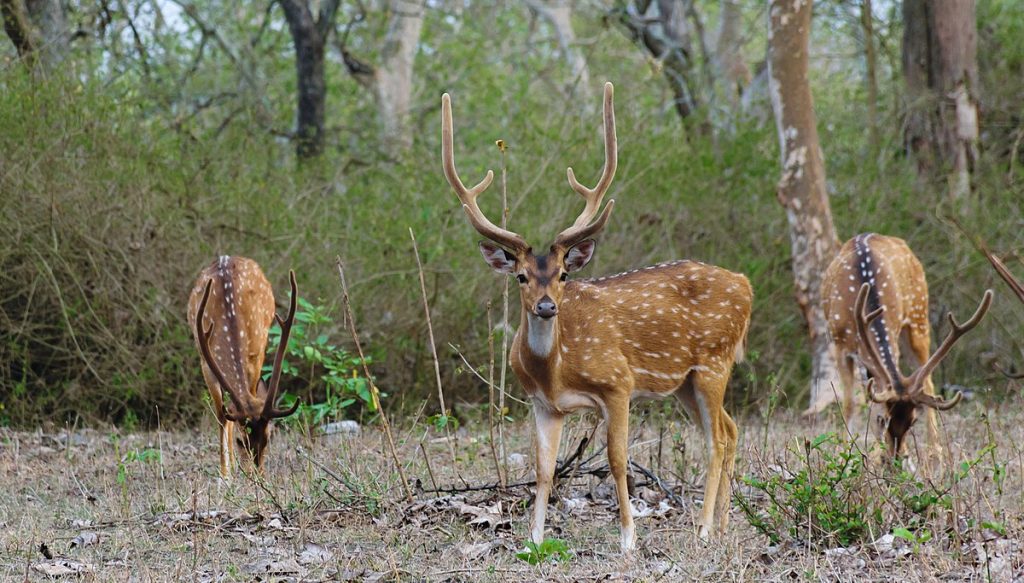
- Scientific name: Axis axis
- Habitat: Asia, introduced to Australia and parts of the United States
- Conservation status: Least Concern
- Antler length: 100 cm / 3.28 ft.
The chital, also known as spotted deer or axis deer, is a medium-sized deer native to the Indian Subcontinent. It thrives in a diverse range of habitats, spanning dense forests to arid deserts.
Introduced populations of chital can be found in Australia, Hawaii, and several locations in mainland United States.
These deer feature a dark, golden-red coat adorned with numerous small white spots. A distinct dark line runs along their backs. Each antler possesses three tines.
Tigers, leopards, wolves, and dholes are among the formidable predators that prey on the chital. In Hawaii, where natural predators are absent, chital populations have proliferated, causing significant crop damage.
3. Elk

- Scientific name: Cervus canadensis
- Habitat: North America, Asia
- Conservation status: Least Concern
- Antler width: 1.22 m / 4 ft.
The elk, the second-largest member of the deer family Cervidae, is surpassed in size only by the moose.
Elks inhabit forests, shrublands, and grasslands across North America and Asia, often favoring mountainous regions and descending to lower altitudes during the winter months.
During the mating season, known as the rut, male elks emit loud and distinctive “bugle” calls to attract females and establish dominance.
Previously classified as a subspecies of red deer, a large European species, elks are now recognized as a distinct species capable of producing hybrid offspring with red deer.
4. Fallow Deer / European Fallow Deer
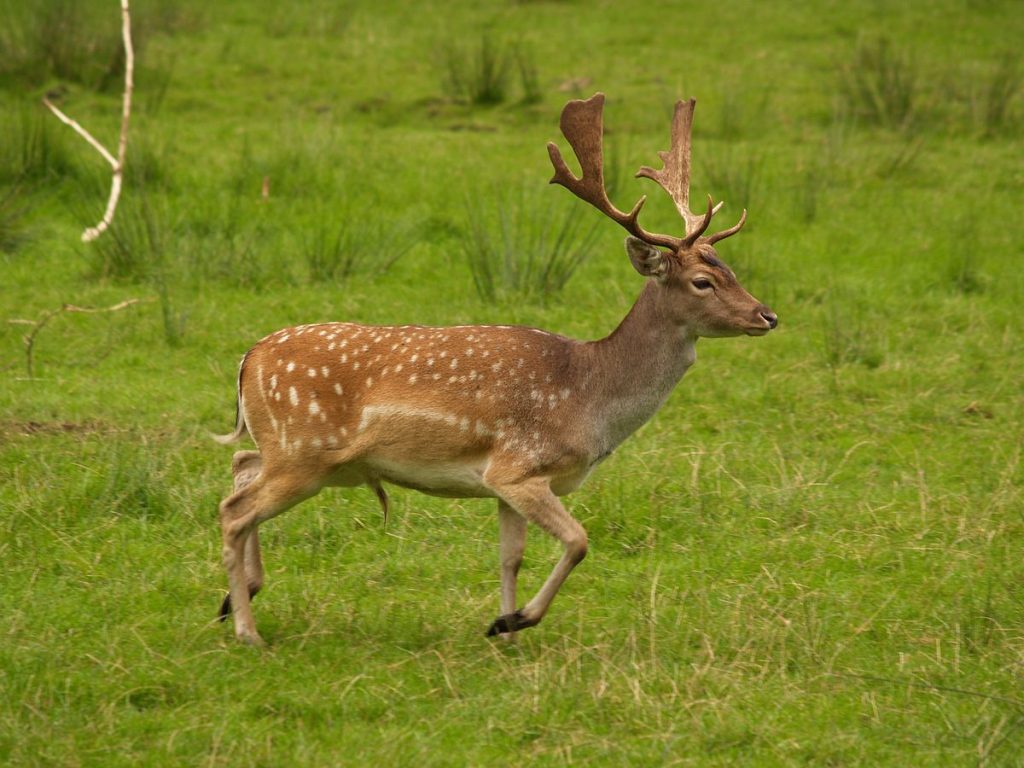
- Habitat: Europe, introduced to North America and Australia
- Conservation status: Least Concern
- Antler length: 70 cm / 2.3 ft.
Originally indigenous to Southeast Europe, fallow deer, also known as European fallow deer, have been introduced to various regions across Europe, including Great Britain. They have also been introduced to Australia and parts of the United States.
Fallow deer typically exhibit a sandy-brown coat adorned with numerous white spots, although coat colors can vary significantly, including all-white and all-black specimens.
Distinguishing them from most other deer species, fallow deer possess palmate antlers, resembling an open hand.
Some zoologists consider the closely-related Persian fallow deer to be a subspecies of fallow deer rather than a separate species.
5. Moose

- Scientific name: Alces alces
- Habitat: North America, Europe, Asia
- Conservation status: Least Concern
- Antler width: 2 m / 6.56 ft
Claiming the title of the largest living member of the deer family, moose stand tall, with males reaching heights of over 2 m / 6.56 ft at the shoulder and weighing up to 700 kg / 1543.24 lb.
Moose possess the largest antlers of any living animal. Uniquely, their antlers take on a palmate shape, resembling an open hand.
What sets moose apart goes beyond their impressive size and antlers. They have distinctively long faces, prominent lips, and a fleshy flap of skin known as a “bell” or “dewlap” hanging from their chins. The exact function of the dewlap remains unknown.
Due to their size and territorial nature, moose can be formidable and even dangerous. Male moose become particularly aggressive during the mating season, while females with calves may also exhibit defensive behavior if threatened.
6. Mule Deer
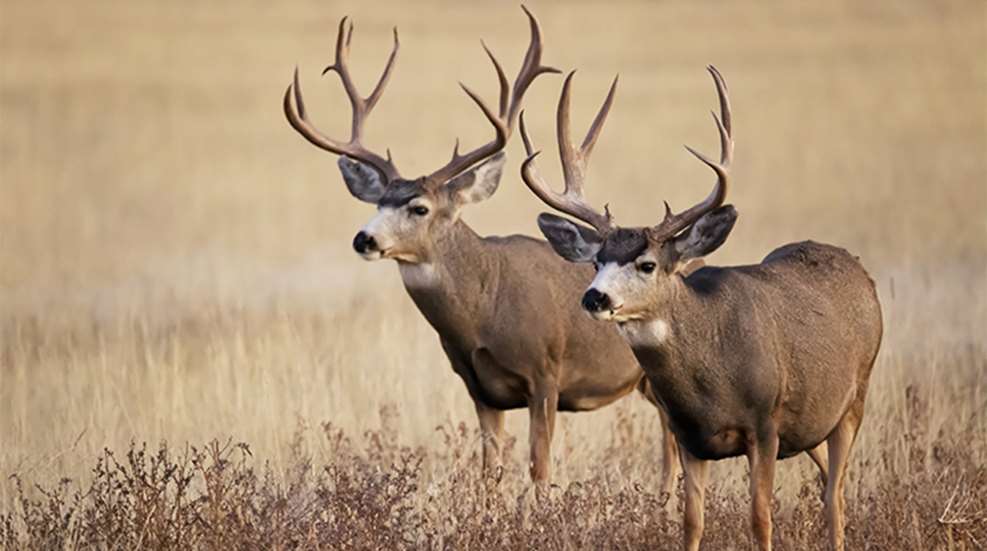
- Scientific name: Odocoileus hemionus
- Habitat: North America
- Conservation status: Least Concern
Native to North America, mule deer can be found in the central and western United States, southwest Canada, and northern Mexico. Their range overlaps with the closely-related white-tailed deer, another native species that inhabits a broader area of North America.
Mule deer derive their name from their large, mule-like ears. They exhibit a range of colors, varying from gray to reddish-brown.
Different subspecies of mule deer include the Rocky Mountain mule deer, California mule deer, and Columbian black-tailed deer. The Columbian black-tailed deer, for example, features black tails, distinguishing them as “black-tailed deer.”
While mule deer antlers branch into pairs of spikes, the antlers of white-tailed deer grow from a single main beam, differentiating the two species.
7. Red Brocket
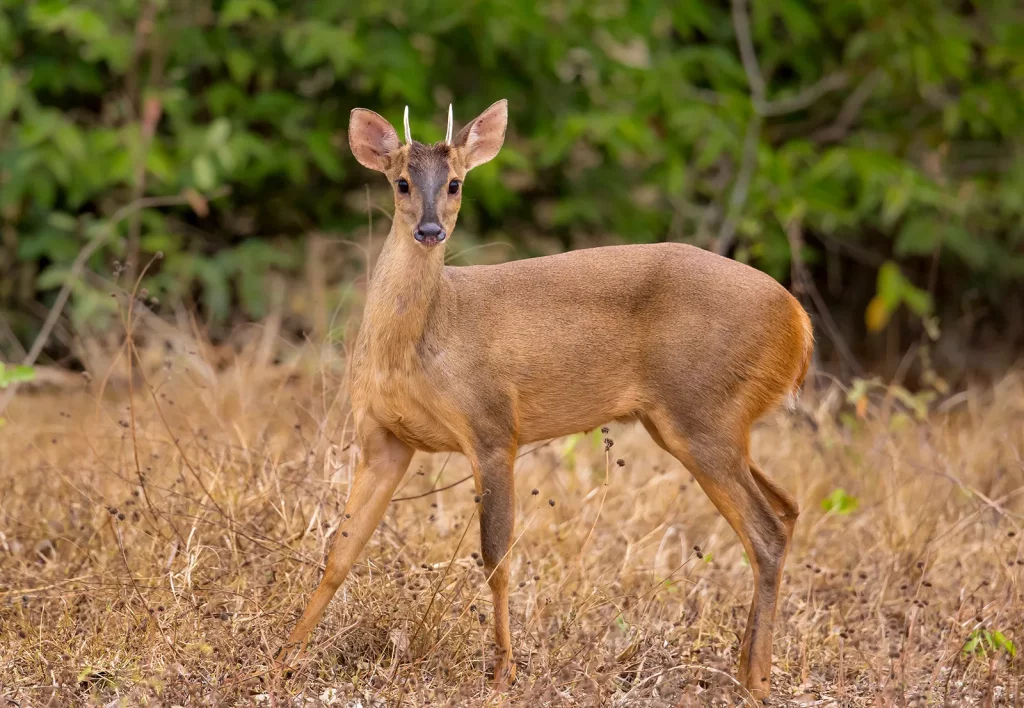
- Scientific name: Mazama americana
- Habitat: South America
- Conservation status: Data Deficient
Inhabiting forests in northern South America, including the Amazon rainforest, the red brocket is a medium-sized deer belonging to the genus Mazama, which encompasses nine recognized species of brocket deer.
With a shoulder height of up to 80 cm, the red brocket is the largest among the brocket deer species. Their antlers, although small, take the form of spike-shaped structures.
8. Red Deer
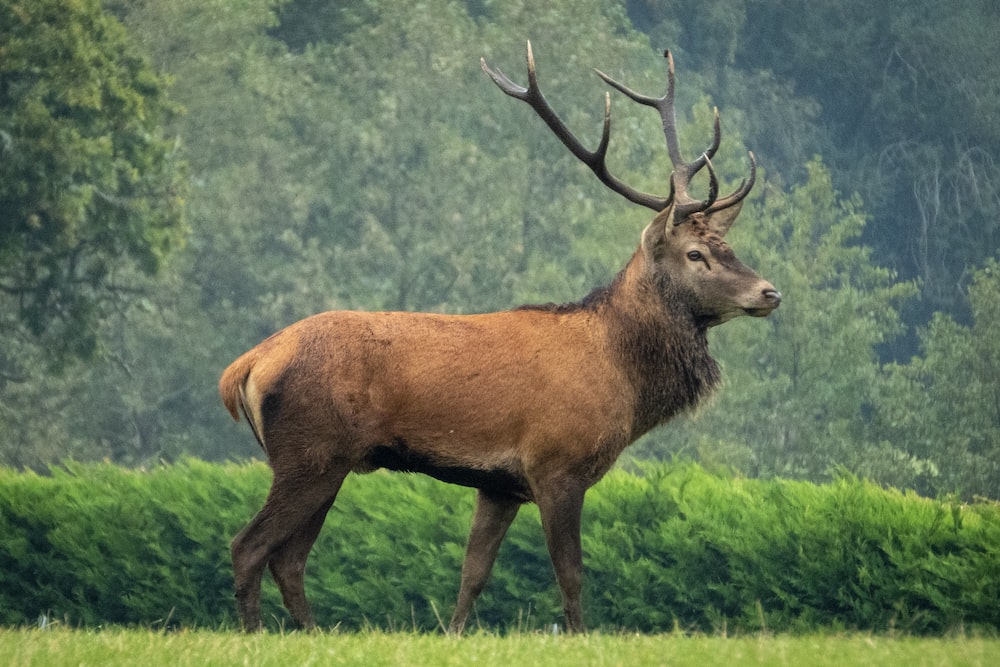
- Scientific name: Cervus elaphus
- Habitat: Europe, parts of Asia, Northwest Africa
- Conservation status: Least Concern
Ranking as the world’s fourth-largest deer species, the red deer stands tall at the shoulder, reaching up to 1.3 m / 4.27 ft. It holds the distinction of being the largest land mammal in the British Isles.
The red deer displays a range of colors, from red-brown to grayish-brown, with variations depending on the time of year and subspecies.
Among the red deer subspecies is the Barbary stag, which represents the only native deer species in Africa. It thrives in dense forests of the northern region and is also referred to as the Atlas deer or African elk.
9. Roe Deer
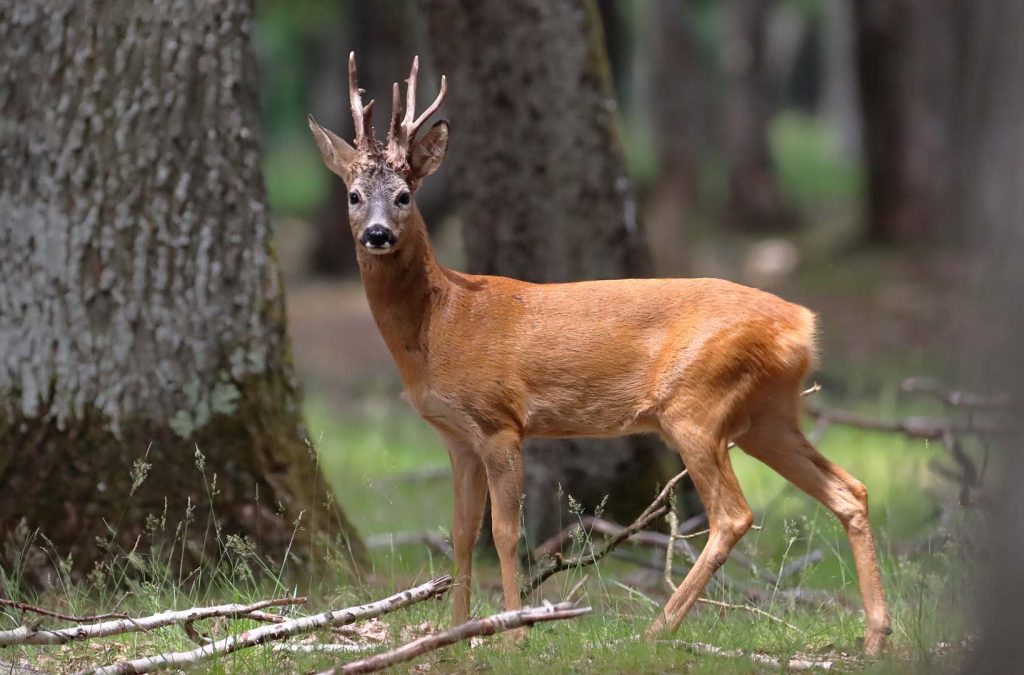
- Scientific name: Capreolus capreolus
- Habitat: Europe, Middle East
- Conservation status: Least Concern
The roe deer, a small species native to Europe and parts of the Middle East, boasts a reddish-gray or red coat, a distinct white rump, and a lack of a tail.
These adaptable deer can thrive in various habitats, leading to an estimated population of around 15 million adult individuals, which is believed to be increasing.
Roe deer antlers are relatively small, typically reaching a maximum length of 25 cm and featuring three points. Notably, the antlers of roe deer begin regrowth shortly after shedding the previous pair.
10. Sambar
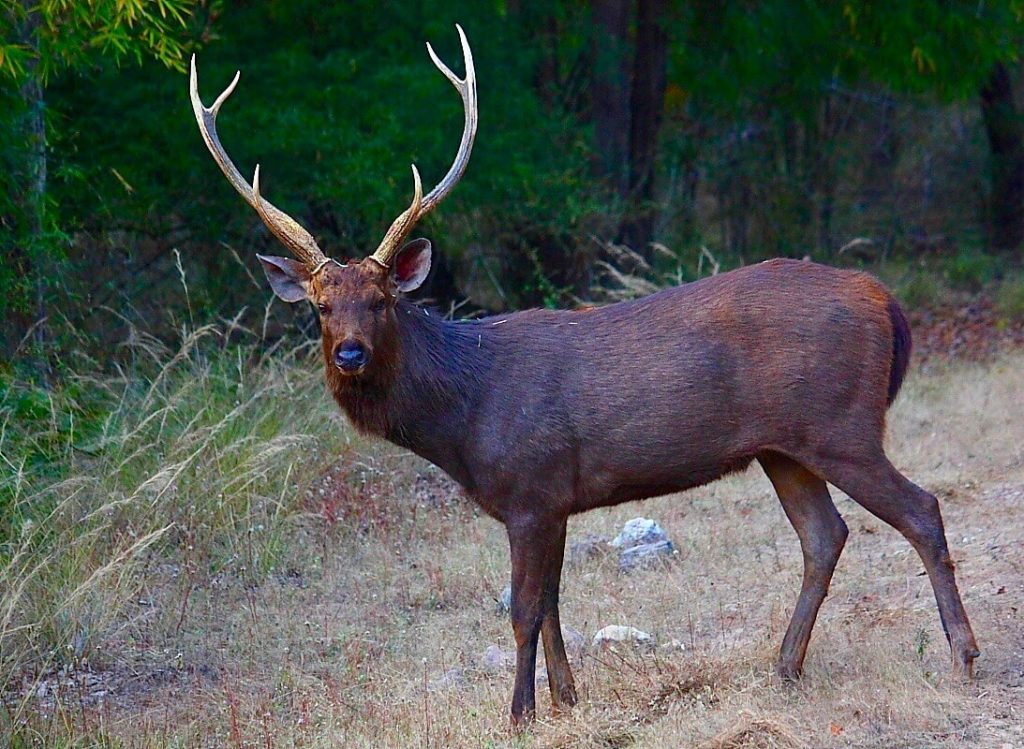
- Scientific name: Rusa unicolor
- Habitat: Asia, Australia (introduced), North America (introduced)
- Conservation status: Vulnerable
The sambar, a large and dark brown deer, can be found throughout much of the Indian Subcontinent and Southeast Asia, including regions like Sumatra, Borneo, Australia (where it was introduced), and parts of the United States.
Standing at a shoulder height of up to 1.6 m / 5.25 ft., the sambar is the world’s third-largest deer species, surpassed in size only by the moose and elk. Their antlers reach lengths of up to 1.1 m / 3.61 ft. and feature three tines or points.
Sambar deer are primarily active during the night or at dawn and dusk. The species faces predation from tigers in Asia, with the big cats often imitating the sambar’s distinctive call.
11. Sika Deer

- Scientific name: Cervus nippon
- Habitat: Asia, North America (introduced)
- Conservation status: Least Concern
The sika deer, a small species native to Asia, has been introduced to parts of Texas and Maryland in North America. They predominantly inhabit dense forests and woodlands but can also be spotted foraging in grassy clearings.
Sika deer can be identified by their small size, wedge-shaped heads, and dark brown coats adorned with white spots. Male sika deer possess antlers with three or four points branching from the main beam.
12. Northern Pudu
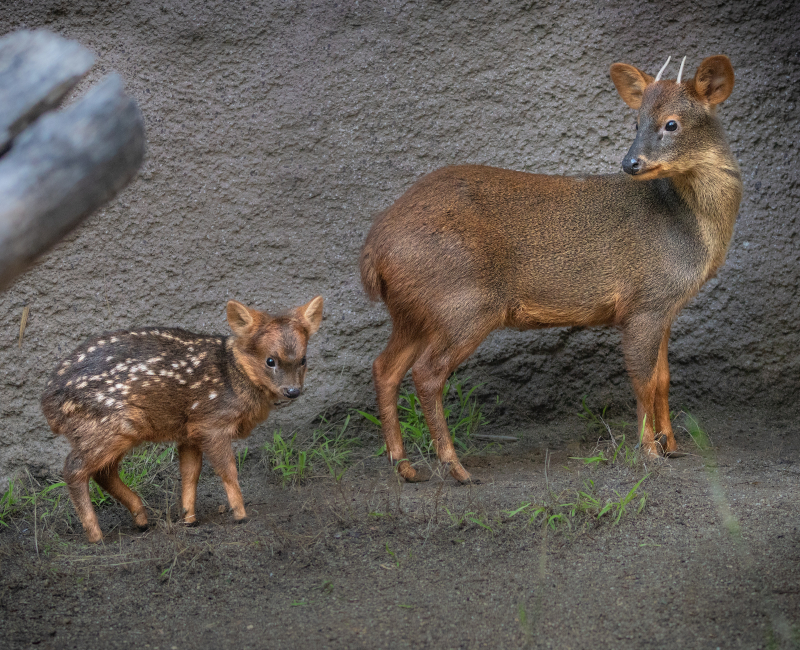
- Scientific name: Pudu mephistophiles
- Habitat: South America
- Conservation status: Data Deficient
Residing in high-altitude Andean forests, shrublands, and grasslands in Colombia, Ecuador, and Peru, the northern pudu claims the title of the world’s smallest deer species. Standing at a maximum shoulder height of 35 cm / 13.78 in., it is slightly smaller than its closely-related relative, the southern pudu, found in Argentina and Chile.
The antlers of the northern pudu are short and spike-like, curving slightly backward and reaching a maximum length of 6 cm / 2.4 in.
13. Taruca

- Scientific name: Hippocamelus antisensis
- Habitat: South America
- Conservation status: Vulnerable
The taruca, a medium-sized deer species, can be found in the Andes of Argentina, Bolivia, Chile, and Peru. It thrives in rocky areas, mountainous shrublands, and grasslands, often inhabiting regions above the treeline.
Taruca antlers consist of two tines branching from the base, with the larger hind tine reaching a length of up to 30 cm / 12 in.
The taruca’s closest relative is the South Andean deer, an endangered species found in the mountains of Argentina and Chile.
14. White-Tailed Deer
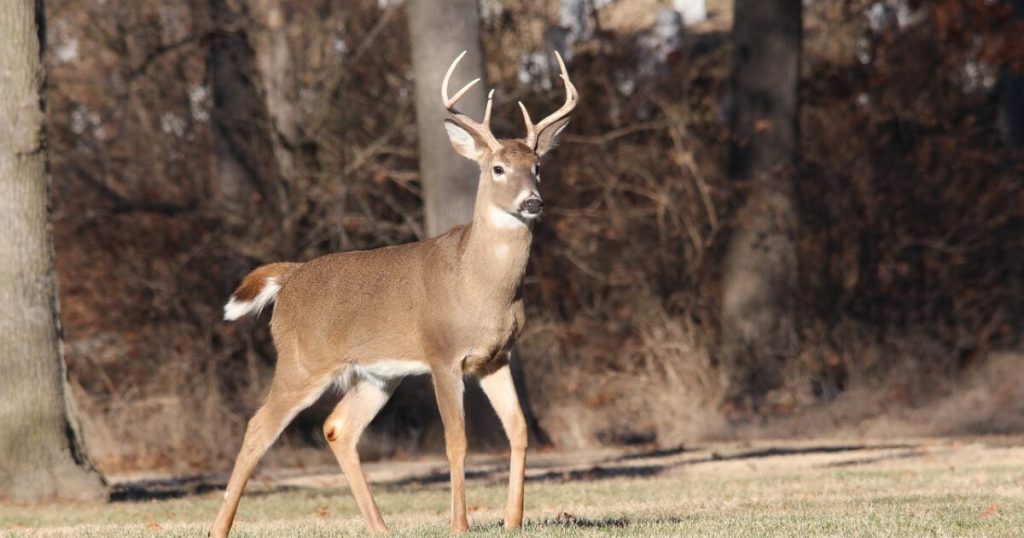
- Scientific name: Odocoileus virginianus
- Habitat: North America, South America
- Conservation status: Least Concern
Closely related to mule deer, another medium-sized deer species native to North America, the white-tailed deer extends its range from Central America into northern South America.
White-tailed deer can be distinguished by their smaller ears, long and white tails, and antlers featuring spikes growing from a main beam rather than branched pairs.
These deer inhabit a wide range of habitats across the United States, including forests, grasslands, coastal areas, and deserts.
Fascinating Facts about Animals with Antlers
- The water deer, Hydropotes inermis, is the only deer species without antlers. Instead, water deer possess small tusks that point downward, resembling fangs.
- Among all deer species, only the caribou (reindeer) possesses antlers in both males and females.
- The moose holds the distinction of being the largest animal with antlers and boasts the largest antlers of any living species. Conversely, the Northern Pudu, a tiny deer found in the Andes of South America, is the smallest animal with antlers.
- Deer can be found on every continent except Antarctica, although they were introduced to Australia by humans.
- Africa is home to only one species of deer, the Barbary stag, which is a subspecies of the red deer.
- Deer have been hunted by humans for thousands of years, resulting in their introduction to various regions outside their native ranges.
Antlers vs. Horns
Unlike horns, which grow continuously throughout an animal’s life and are never shed, antlers undergo annual growth and shedding.
Antlers are composed of bone and are extensions of the animal’s skull. They are known for their rapid growth, with the ability to grow up to one inch per day, making them the fastest-growing animal bones.
In contrast, horns have a two-part structure, consisting of a central core of bone surrounded by a sheath of keratin.
Antlers are exclusive to the deer family, Cervidae, while horns can be found in two animal families: Bovidae (cattle family) and Antilocapridae (pronghorn family).
As you delve into the world of animals with antlers, may you appreciate the diverse beauty and wonder found among these remarkable creatures.